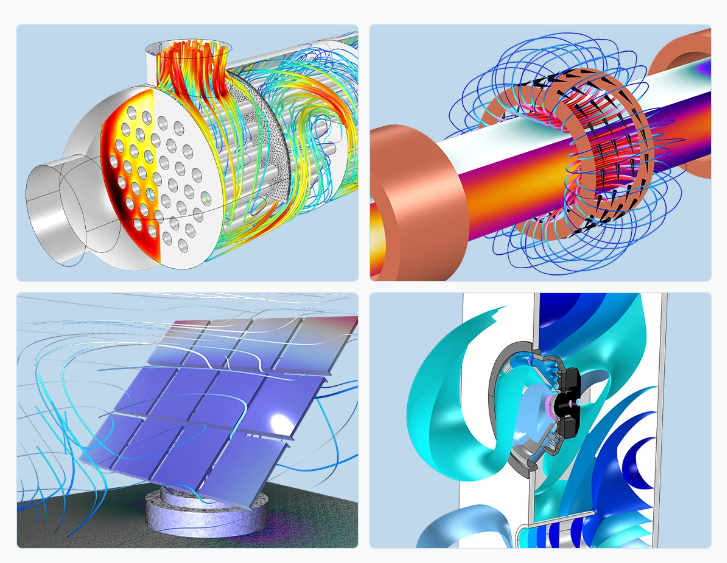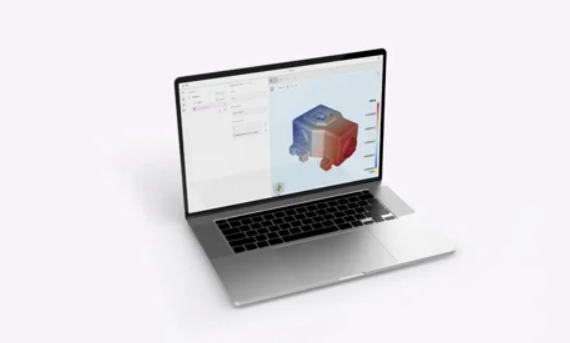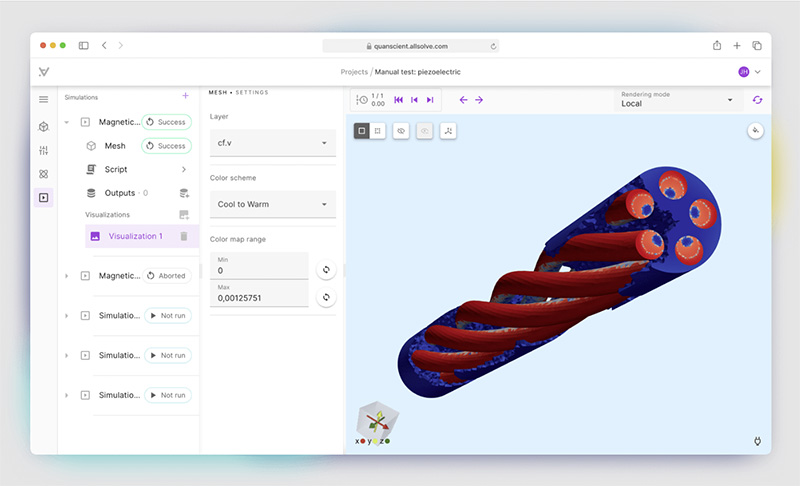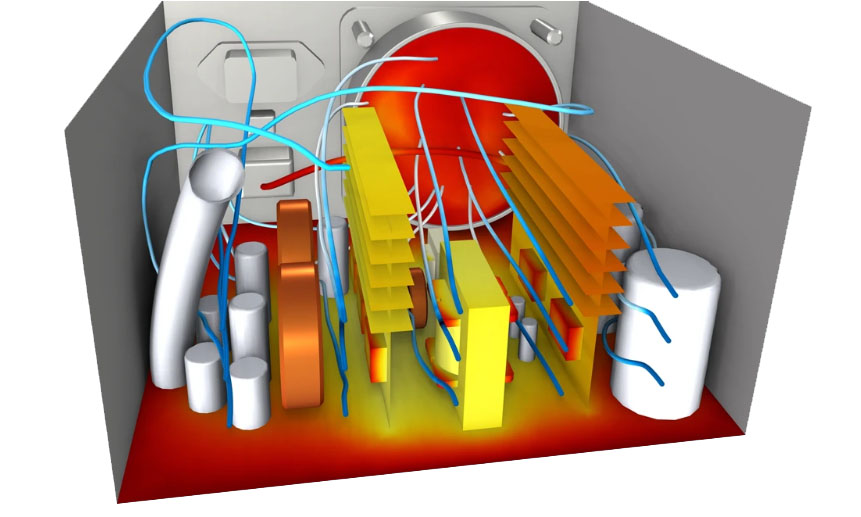In the dynamic world of engineering, having access to the right simulation platform can be the key to unlocking innovation, efficiency, growth, and future success. COMSOL and Quanscient are two prominent engineering platforms offering comprehensive solutions for various simulation needs.

Whether you are an experienced engineer or a student starting your engineering journey, selecting the right software development platform for your simulation needs can significantly impact your future project flow and overall productivity.
What is Multiphysics Simulation?
Multiphysics simulation is a computer-based method of analyzing physical systems involving multiple processes. It helps engineers understand complex systems with different physical domains, such as fluid flow, heat transfer, mechanics, electromagnetics, and chemical reactions. Engineers can optimize designs, predict system performance, and make informed decisions by considering these interdependencies. It is an essential tool in various industries, helping to explore and understand complex physical phenomena and develop innovative engineering solutions.

What is Multiphysics Software?
Multiphysics software is a specialized type of engineering software that enables engineers and researchers to simulate and analyze physical phenomena involving multiple interconnected physical domains or phenomena. It allows for the integrated modeling and simulation of elements of various physics disciplines, such as fluid dynamics, heat transfer, structural mechanics, electromagnetics, and chemical reactions.
In traditional engineering simulations, individual physics domains' classical problems are often treated independently, neglecting the interactions and interdependencies between them. However, many real-world problems require a comprehensive understanding of the coupled effects and interactions between different physics phenomena.

Multiphysics software addresses this challenge by providing a platform where engineers can model, simulate, and analyze the coupled behavior of multiple physical phenomena in a unified framework. By integrating multiple physics domains, multiphysics software enables engineers to obtain more accurate and realistic simulations, leading to better insights, improved design optimization, and more reliable engineering decisions. It plays a crucial role in various fields, including aerospace, automotive, energy systems, biomedical engineering, and many others, where the interactions between different physics phenomena are critical to the overall system behavior.
Simulation Software Considerations
This blog will thoroughly compare COMSOL and Quanscient, exploring their features, capabilities, user interfaces, and support resources.
By examining and evaluating these aspects, we aim to provide engineers and researchers with the necessary insights to make an informed decision based on their specific industry requirements and research objectives.
Understanding the Features
COMSOL and Quanscient are powerful engineering platforms that cater to multiphysics simulations, allowing engineers to analyze complex physical phenomena involving various domains such as fluid dynamics, structural mechanics, electromagnetics, and heat transfer.
However, subtle differences in their feature sets can influence the choice of platform.
COMSOL is renowned for its versatility, offering a wide range of built-in physics and geometry modules, coupled physics and geometry interfaces, and customization options. Its extensive library of pre-defined models and multiphysics couplings makes it suitable for tackling diverse mechanical engineering problems.
Additionally, COMSOL provides a user-friendly interface and comprehensive documentation, making it accessible to both beginners and advanced users.
Quanscient, on the other hand, focuses on providing customers with a streamlined user experience and intuitive workflow. Quanscient.allsolve offers efficient solvers and advanced algorithms that enable fast and accurate simulations.

Quanscient also emphasizes AI-driven optimization capabilities, allowing engineers to quickly see design parameters, automate the design exploration process, and discover optimal solutions.
Considering User Interface and Workflow
User interface and workflow are crucial in an engineering platform's efficiency and ease of use. COMSOL employs a graphical user interface (GUI) that enables users to create and modify simulation models using a visual approach method.
It provides a drag-and-drop functionality, making it easier to define geometries, boundary conditions, pressure, and other fluid physics settings. COMSOL's comprehensive documentation, tutorial resources, and active user community also contribute to a smooth learning curve.
Quanscient emphasizes a more command-line-driven interface, catering to users who prefer scripting and automation. Its workflow focuses on simplicity and efficiency, enabling users to quickly set up simulations and analysis using a text-based input format.

Quanscient's user community and support resources provide ample guidance and tools for users to become proficient in the platform.
User Interface and Ease of Use
Both COMSOL and Quanscient provide user-friendly interfaces, enabling engineers to create, modify, and analyze simulations. COMSOL's interface is known for its comprehensive and intuitive layout, offering a wide array of pre-defined model modules and physics interfaces.
Quanscient adopts a minimalist approach with a clean and simple interface, focusing on providing essential functionalities and functions without overwhelming the user. This makes Quanscient particularly suitable for beginners or engineers who prefer a streamlined experience.
Physics Capabilities
COMSOL is renowned among industry, for its extensive library of tens of thousands of physics models and modules, covering a broad range of disciplines, including structural mechanics, fluid dynamics, electromagnetics, heat transfer, and more. The platform allows for complex multiphysics simulations, enabling engineers to analyze coupled phenomena.

Quanscient, while relatively newer, also offers a growing library of physics models and modules, albeit with a narrower focus. However, it excels in providing a unified workflow and seamless integration with advanced machine learning algorithms, making it an excellent choice for engineers interested in combining their simulation tools with data-driven approaches.
Solver Performance and Simulation Speed
Both COMSOL and Quanscient employ powerful solvers to handle complex simulations efficiently. COMSOL's solvers are well-established and highly optimized, providing robust and reliable performance. It offers a range of solvers catering to different physics domains, ensuring accuracy and stability across simulations and devices.
Quanscient simulation software solution leverages state-of-the-art numerical techniques optimized for speed and accuracy. It utilizes advanced algorithms to accelerate simulations, making it an attractive choice for engineers working on large-scale or time-sensitive projects.
Customization and Extensibility
COMSOL boasts a versatile platform that allows engineers to customize their simulations extensively. It offers a comprehensive development environment, enabling users to develop custom physics modules and implement user-defined equations.
COMSOL also provides an Application Builder module solution that facilitates the creation of application modules with specialized user interfaces, simplifying the sharing and deployment of simulation models.
Quanscient, although more limited in terms of customization tools, provides a Python-based interface that empowers engineers to leverage the browser and vast ecosystem of scientific libraries and tools, enhancing flexibility and integration possibilities.
Support Resources and Community
Access to support resources and a vibrant user community can be invaluable when using an engineering platform. COMSOL offers comprehensive technical support, including online documentation, video tutorials, user forums, and direct support from their expert team. The COMSOL community is active and diverse, with a wealth of knowledge-sharing and problem-solving discussions.
Quanscient, while a relatively newer software, is rapidly growing its support resources, technology, and community. The company provides documentation, examples, tools, and tutorials to assist users in getting started. The community-driven support forums encourage collaboration and knowledge exchange among users.
Conclusion: Choosing Your Core Multiphysics Package
Selecting the right engineering platform is a crucial decision that can significantly impact your simulation projects and productivity. COMSOL software and Quanscient both offer powerful capabilities, intuitive interfaces, and valuable support resources.
COMSOL's versatility and extensive feature set make it an excellent choice for engineers with diverse simulation needs. Quanscient's streamlined workflow, fast solvers, and AI-driven flow model optimization capabilities cater to users seeking efficiency and automation in simulation applications.
Ultimately, the choice between COMSOL and Quanscient depends on your specific industry requirements, project objectives, and personal preferences.
We encourage you to explore their features, test their user interfaces, and leverage their support resources to make an informed decision.
Remember, the right engineering and technology platform will empower you to unlock innovation, accelerate simulations, optimize cost, and confidently achieve your engineering goals.
If you’d like to see more blogs on engineering solutions, consider subscribing to my blog or YouTube - and feel free to leave a comment down below! 🙂
Keep engineering your mind! ❤️
Jousef

